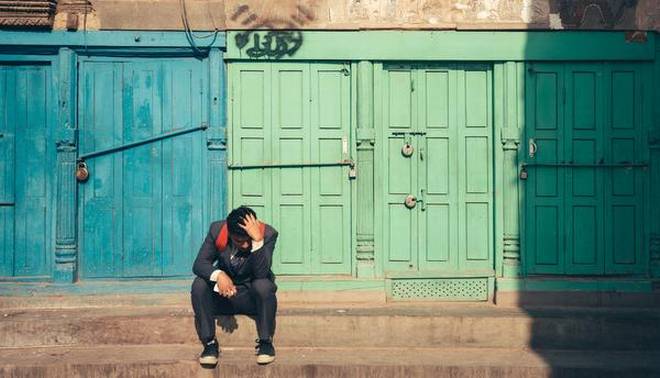
Poorly designed cities and buildings impact us in more ways than one. We could use the post-Covid era as a chance to make changes in our living environment
Most of us are used to navigating serpentine traffic jams on potholes-ridden roads on the way to work every morning. We stare at pictures of soothing mountains and blue skies, wishing we could get away when our dull, bare office walls remind us to get back to work. Overall, urban workers are stressed, irritable and anxious. We can brush it off as just another city life syndrome, but it turns out our surroundings impact us in more ways than you can imagine.
According to the Centre for Urban Design and Mental Health (UD/MH), cities are associated with higher rates of most mental health problems compared to rural areas: an almost 40% higher risk of depression, over 20% more of anxiety, and double the risk of schizophrenia, in addition to loneliness, isolation and stress. In India, while we are beginning to see how urban design impacts physical health, only a handful of experts understand the links between mental health and our poorly designed cities.
The Covid pandemic has highlighted the need to put people first and create liveable cities. Perhaps we won’t get another chance to relook at the designs of our neighbourhoods and make our post-Covid world more liveable.
Layla McCay, Director of London-based UD/MH, says the crisis has underlined the importance of the public realm for our health, both in terms of keeping us in good health (such as with infrastructure like parks and friendly urban designs) and in reducing the risk of infection (such as having wider pedestrian paths to allow for social distancing, etc.)
How it can be done
McCay explains that the design of buildings and cities can support mental health by increasing people’s access to high quality, well-maintained green spaces with diverse plant and animal life. “Even views of natural settings from buildings may have some benefit.” In addition, designing to reduce loneliness and promote positive social interaction is key. “Many millions may live in cities, but despite this, people often feel a sense of social isolation that can be addressed by urban design. This includes designing homes and neighbourhoods with local amenities, including parks, within walking distance,” she says. She talks of integrating physical activity into people’s regular routines by investing in safe walkways, street connectivity, and good quality public transport. City designers or architects must consider mental health as an objective from the very start of any project, says McCay.
New York’s International WELL Building Institute (IWBI) — known for its global rating system, WELL Building Standard —leverages buildings and communities as tools for public health and well-being. Emily Winer, IWBI’s WELL Mind Concept Lead, says, “Beyond buildings, the WELL Community Standard highlights the need for nature in the urban environment. Urban green spaces, for example, are associated with a range of short- and long-term mental health benefits, positively affecting age groups across the lifespan, from children to older adults.”
A snapshot of Hong Kong’s Tsim Sha Tsui promenade in February | Photo Credit: Matt Leung
Ben Channon, a member of IWBI’s Mind Concept Advisory, explains that while corporate benefits like gym memberships, working from home, and mental health days have become more commonplace, there’s more to the conversation. “The impact that design can have on our well-being is often left by the wayside, especially in terms of our emotional responses. Messy homes can stimulate the release of cortisol, a hormone that makes us experience stress. Similarly, the lack of control and unpredictability associated with commuting to work can increase cortisol production, and the stress is likely to linger throughout the day, resulting in decreased happiness and diminished productivity.” In his first book, Happy by Design: A Guide to Architecture and Mental Wellbeing, Channon explored the latest scientific findings to identify the nexus of neuroscience, psychology, architecture and mental well-being.
Many of the ideas discussed in the book can be integrated into a building’s design without huge cost implications. One common solution that developers and designers are pursuing is the allocation of space to promote activity and boost endorphins. For example, the designation of a single location for a coffee machine encourages staff to move around and socialise with fellow employees,” he says. Channon also recommends the incorporation of natural and tactile materials (wood, natural fibres, etc.) that engage directly with the sense of touch. Such design principles are important for affordable housing too, a key concept being promoted in India over the last few years. “An approach to affordable housing design that’s consciously centred on well-being could provide vital support to those who often have the fewest resources to address mental health issues, but who tend to need it the most,” he says.
India-centric
While such design interventions have been studied and implemented abroad, we need new methods for the post-Covid world. Avikal Somvanshi, Programme Manager, Sustainable Cities Programme at New Delhi’s Centre for Science and Environment, points out that the many ratings of most liveable cities worldwide have all been dominated by cities from the U.S. and Europe. “Given the fact that these very cities became a hotbed for the pandemic and had the most fatalities, we ought to revisit what we mean by liveable and healthy cities,” he says.
- The National Mental Health Survey in India (2015-2016) reiterated the growing burden of mental health issues in our metros. Some common conditions shown to be more prevalent in urban areas include depression, anxiety across age groups, high suicide rates, substance use disorders, and dementia.
- I make it a point to ask my patients where they are coming from, since their immediate living environment is key. Recently, a 45-year-old woman in Chennai approached me with symptoms of anxiety after moving to a crowded locality from her ancestral home in a quiet zone. It is important to note that more women suffer from depression, especially those from lower-income groups. Increased stressors such as overcrowded and polluted environments, violence, and reduced social support are to blame.
- Even until a decade ago, senior citizens could commute easily, but today they are anxious to step outdoors. The fear of accidents, difficulties in crossing roads, chain-snatching incidents, absence of walkways, etc. have a negative impact on the elderly.
Explaining how COVID-19 has completely altered the meaning of a healthy space globally, Somvanshi looks at how closed air-conditioned spaces that were the bedrock of quality infrastructure are no longer considered safe. “We need ventilation and social distancing now, and traditional Indian architecture and city design has prioritised ventilation. Open-air markets and recreational spaces have been a staple in our cities, things we are now learning are critical in reducing the exposure to and spread of air-borne viruses and infections like COVID-19.” The danger, he says, lies in overcrowding and the way forward lies in finding better management and designs for that while making sure “we don’t unnecessarily shift public utilities and spaces into air-conditioned buildings like malls,” says the architect.
Shalini Ramesh, Director of Market Solutions at IWBI, explains that there has been strong interest in WELL from Indian architects, designers, developers, and policymakers. “We did a WELL roadshow in February 2020 across Chennai, Bengaluru, Mumbai and Delhi. As of May 2020, there are 80 projects that have been WELL certified or are registered for certification.
All eyes on Delhi
UD/ MH has published case studies on Delhi’s gated communities and the impact of high-rise living on mental health. This autumn, a Delhi case study will be published. New Delhi-based architect and urban designer Kriti Agarwal, who has worked on the case study, examines if and how the capital has used the principles of urban design to ensure mental well-being of its inhabitants. Agarwal, an assistant professor at Jindal School of Art & Architecture, explains that 49% of the city’s total population resides in slum areas, “unauthorised colonies”, and 860 jhuggi-jhopri clusters without civic amenities. She points out that Delhi Metro has aided commuting, but there is a huge shortfall of buses. “First and last mile connectivity remains a major issue; 35% of the city walks, 27% uses buses and 7% uses autos/ cycle-rickshaws,” she says.
The latest (2008) report on the State of Mental Health in Delhi shows high levels of distress and poor subjective well-being. “The significant stressors indicated were crowded roads, larger distances, traffic problems, disturbed and erratic routines, migrations of people resulting in a diluted culture and weak community links, lawlessness and fear for safety, especially of women, children and the elderly,” says Agarwal. She adds that people reported material well-being but poor life satisfaction.





















